CCMSA Delegation’s Southeast Asia Inspection Tour Concludes Successfully
To implement the plans and objectives agreed upon at the China-ASEAN Ministerial Roundtable on Construction, the China Construction Metal Structure Association (CCMSA) launched an inspection tour to ASEAN countries from November 18 to 29, 2024, intended to explore their current development status and market demand in the construction industry, thereby helping Chinese door and window companies expand overseas, and to ensure the successful organization of the 2025 China-ASEAN International Building Products and Equipment Expo (CABE). Comprising top representatives from China’s door and window industry, the delegation visited four ASEAN members: Cambodia, Vietnam, Thailand, and Malaysia. Throughout the tour, the delegation met with local government agencies and Chinese chambers of commerce, conducted comprehensive market research on the door and window sectors, and gained valuable insights into local prevailing standards, regulatory frameworks, market prospects, and market access policies. The delegation was warmly received by local government agencies, political parties, and business associations. The tour proved to be a resounding success.
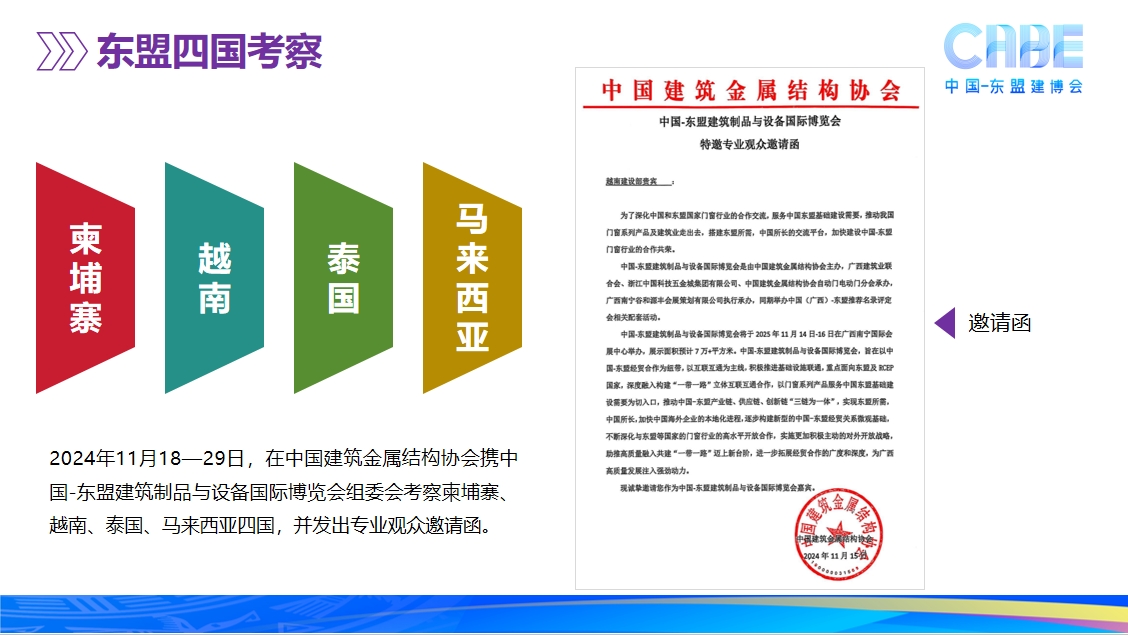
On the morning of November 19, the delegation began its tour by visiting the Cambodian National Police’s Department of Fire Prevention, Extinguishing and Rescue. They were received by Director Neth Vantha, along with Deputy Director, Office Director, Director of the Comprehensive Department, and Director of the Legal Department.
Pan Guanjun, Deputy Secretary-General of CCMSA, introduced the delegation members and signature products of the representative companies. In his remarks, Neth Vantha detailed Cambodia’s natural resource advantages and the notable achievements of the Department since its inception. Cambodia has experienced rising fire incidents amid its rapid post-war reconstruction and the burgeoning revival of various industries. Even more critically, the nation’s shortage of domestic manufacturers for fireproof components has forced it to rely on imported products from its neighbors such as Vietnam and Thailand, which come with long lead times and high prices. Impressed by the state-of-the-art, high-quality fireproof door and window products showcased at the 14th China (Yongkang) International Door Industry Expo in China in May 2024, Neth Vantha expressed hope that Chinese companies would invest in establishing manufacturing facilities in Cambodia or expand their exports to the country. He also noted that construction on the Funan Techo Canal, a joint China-Cambodia project linking Phnom Penh Port on the Mekong River to the sea outlet in Sihanoukville Province, has begun; once completed in four years, it will greatly facilitate both the import of Chinese products and the supply of raw materials for production in Cambodia.
Moreover, Cambodia is drafting building fire safety regulations, with the relevant fire safety and industrial authorities also working on standards for fireproof doors and windows. To foster economic development and attract foreign investment, the Cambodian government has adopted a relatively flexible regulatory approach. Given this, CCMSA is encouraged to spearhead coordination between Chinese companies and Cambodian counterparts to jointly formulate these standards. Once registered with the Cambodian Ministry of Interior, they would be implemented, with the Cambodian National Police’s Department of Fire Prevention, Extinguishing, and Rescue also assisting in promoting Chinese products.
On the afternoon of November 19, the delegation visited the Cambodian Ministry of Land Management, Urban Planning, and Construction. They were warmly received by four senior officials: Chhann Sorphal, Director-General of General Department of Construction; Chiek Wirak, Director of the Project Research Department; Tith Khemara, Director of the Construction Department; and Moueung Sokleath, Director of the Economic Planning and Finance Department. Chhann Sorphal briefed the delegation on Cambodia’s post-pandemic construction market development. He noted that ongoing projects involve approximately USD four billion in investment, with 60% of the required construction materials imported due to limited local resources—hillstone, river sand, and bricks. He encouraged the CCMSA to facilitate collaboration among building materials companies across the supply chain to establish industrial parks. Additionally, he highlighted the potential for creating a special economic zone with tax incentives, and mentioned that land for factory development is available for purchase or lease.
He also noted the absence of national standards for common building materials such as doors and windows in Cambodia, with the General Department of Construction working on it. Products from Chinese manufacturers that are tested and found compliant with Chinese standards are eligible for export to Cambodia for use in construction projects. The General Department of Construction has also established a testing laboratory, with plans to introduce a certification system and market access mechanism. Regarding collaboration with CCMSA, he proposed forming a joint liaison group, establishing a CCMSA office in Cambodia, and signing a memorandum of understanding to further advance cooperation.
On the morning of November 20, the delegation visited the Guangxi Chamber of Commerce in Cambodia (GCCC). They were warmly received by key representatives, including Xie Zhan, President of the GCCC and Chairman of the Cambodia-ASEAN International Logistics and Trade Center; Lu Shangchu, Vice President of the GCCC and Deputy General Manager of the Cambodia-ASEAN International Logistics and Trade Center; Nie Jinsong, Director of the Cambodia Office of Guangxi Yemao Construction Group Co., Ltd.; and Liang Chunzhao, Deputy Director of the Cambodia Office of Guangxi Yemao Construction Group Co., Ltd.
Pan Guanjun introduced the delegation members and CCMSA. Drawing on his decade-long experience, Mr. Xie elaborated on Cambodia’s public security and investment environment, the streamlined company registration process, land pricing, and key considerations for land transactions. He noted that the current market for doors and windows in Cambodia is dominated by mid-to-low-end products, with no large-scale local manufacturers. Most profiles and accessories are imported, creating an opportunity for Chinese companies to export these components to Cambodia for local assembly and use in construction projects. Mr. Xie also encouraged CCMSA to organize Chinese companies to establish operations within the Cambodia-ASEAN International Logistics and Trade Center. With a planned total construction area of 600,000 square meters, the Trade Center has completed its first phase, covering 430,000 square meters. It stands as Cambodia’s largest integrated trade hub for fruits and vegetables, building materials and hardware, and small commodities.
In Phnom Penh, commercial outlets predominantly utilize glass spring doors and roller shutter doors, with a few employing sliding doors for their entrances. Outdoor enclosures feature steel sliding gates, stainless steel retractable gates, and a limited number of aluminum alloy retractable gates. Residential buildings primarily use non-insulated single-glazed aluminum alloy sliding windows, top-hung outward-opening windows, and simple old-style wooden windows. The local market is mainly dominated by aluminum alloy windows from China in the 1980s.
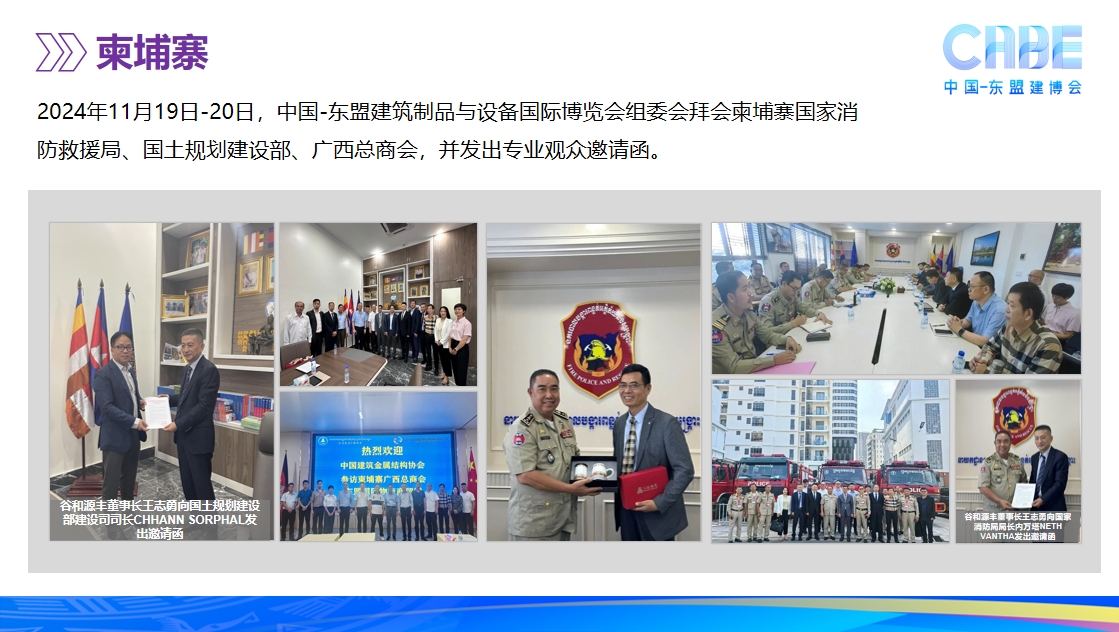
The delegation visited the Vietnamese Ministry of Construction on the morning of November 21. They were warmly received by four senior officials: Le Hoang Trung, Deputy Director of the Urban Development Agency; Bui Nhu Quynh, Chief Expert of the International Cooperation Department; Tran Ngoc Linh, from the Urban Development Management Department; and a representative from the Housing and Real Estate Department.
Pan Guanjun introduced CCMSA, the delegation members, and the purpose of the visit. Mr. Le briefed the delegation on Vietnam’s national urban construction situation. He highlighted that Vietnam, with a population of 100 million, has an urbanization rate of 43%, which is expected to reach 50% by 2030 and over 70% by 2050. The country aims to provide affordable housing for one million low-income individuals annually. In 2021, the Chinese Ministry of Housing and Urban-Rural Development and the Vietnamese Ministry of Construction signed a Memorandum of Understanding on cooperation in the fields of housing and urban construction. The cooperation covers seven areas: urban renewal, housing construction and management, urban water supply, wastewater treatment and solid waste management, green building development, construction engineering standards and regulations, and smart city building.
Mr. Le emphasized that Vietnam, as a developing country, has substantial demand for construction materials, highlighting opportunities for bilateral cooperation in residential and infrastructure projects. He noted that Vietnamese standards for doors and windows draw reference from European standards, with the Department of Science and Technology responsible for their development. Regarding green building development, Mr. Le underscored Vietnam’s commitment to achieving net-zero emissions by 2050, with the government prioritizing green development and a green economy. To support this, Vietnam encourages the use of green building materials in construction projects and hosts an annual Green Building Week in September and October. He expressed a strong interest in strengthening cooperation with China in green building materials and suggested further discussions via email with the designated contact. Additionally, Mr. Le mentioned that Vietnam hosts 2-3 building material exhibitions annually and expressed that the organizers of these exhibitions could be potential supporters and participants for the CABE 2025.
On the afternoon of November 21, the delegation visited the Business Association of China in Vietnam. They were received by four representatives: Shi Jianya, Vice President and Secretary-General of the Business Association; Shi Shici, Deputy Secretary-General of the Business Association; Zheng Chuang from CCCC Third Harbor Engineering Co., Ltd.; and Ma Liming, Deputy Representative of Vietnam Office of China Harbour Engineering Company Ltd.
Pan Guanjun introduced the delegation members and the signature products of the representative companies. Mr. Shi briefed the delegation on Vietnam’s basic national conditions, the Business Association of China in Vietnam, and the Chinese-funded companies in Vietnam. Vietnam is the fastest-growing economy among ASEAN countries, with Hanoi and Ho Chi Minh City being megacities with populations of over ten million. Affected by the US-China trade war, over the past five years, many Chinese-funded companies have relocated to Southeast Asian countries such as Vietnam, Indonesia, Thailand, and Malaysia. However, since 2023, the US’s cancellation of exemption policies has significantly impacted exports from Vietnam, Thailand, and Indonesia.
Founded on August 6, 2001, the Business Association of China in Vietnam has grown to become the largest overseas business association for Chinese companies, with more than 4,000 member companies. Over 15,000 Chinese-funded companies operate in Vietnam. The Association has three regional branches and two industry associations (for photovoltaics and healthcare) under its umbrella, offering a wide range of services including business development support, professional assistance, and organizing various activities for its members.
Despite higher production costs in Vietnam compared to China, the country’s tariff advantages for exports to Europe and America, particularly amid rat race in the Chinese market, present significant opportunities in the Vietnamese market.
Regarding the CABE, Mr. Shi indicated that the Association could coordinate with the Vietnam Chamber of Commerce and Industry (VCCI) to organize local buyers to visit the CABE and participate in relevant supporting activities.
On November 23-24, the delegation conducted on-site visits to hardware, electromechanical, and home furnishing markets located on three streets in Hanoi, Vietnam. In this city, commercial establishments predominantly use glass spring doors, roller shutter doors, and sliding doors for entrances. Outdoor enclosures typically feature stainless steel and aluminum alloy retractable gates, while high-end hotels often install swing gates at their entrances. In residential buildings, mid-to-high-end windows are mainly non-insulated double-glazed aluminum alloy casement windows.
Vietnam’s building materials market has reached a mature stage, with local manufacturers already establishing a solid foundation in producing roller shutter doors, simple wooden doors, and non-insulated aluminum windows. Chinese companies can either find local agents or establish their own offices in Vietnam for sales. In the future, as the Vietnamese government places more emphasis on energy-efficient buildings, there is expected to be significant growth in the use of insulated aluminum alloy doors and windows, as well as plastic steel ones.
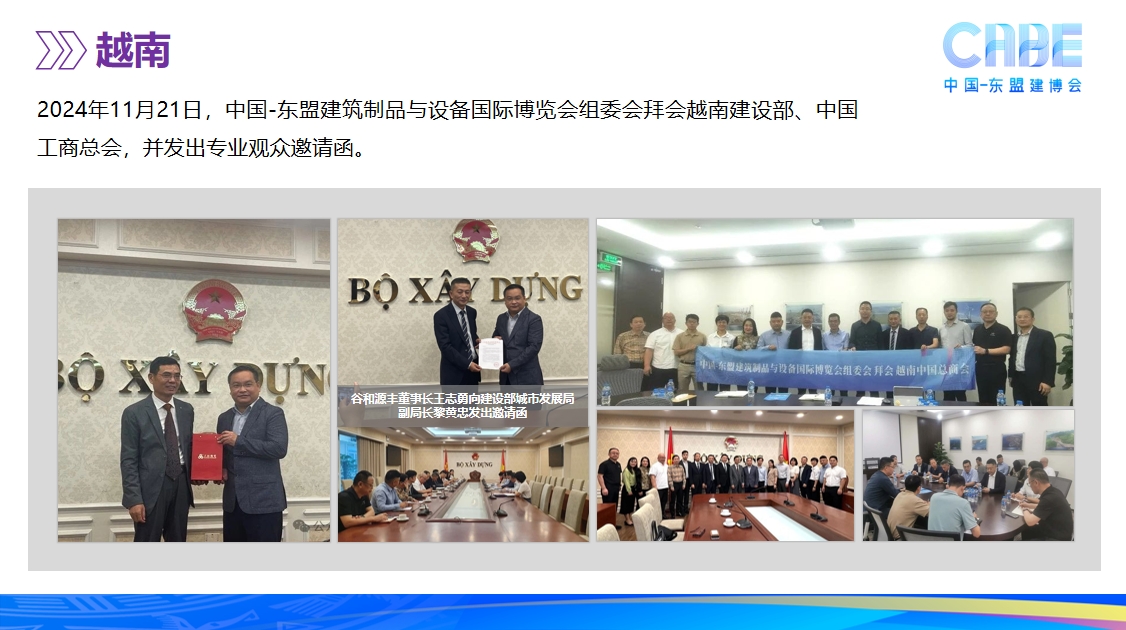
On November 25, the delegation visited HomePro and BnB, both major building material supermarkets in Bangkok, Thailand. They offer a comprehensive range of building hardware, bathroom fixtures, and home furnishings. Their door and window products primarily consist of indoor PVC doors, composite wooden doors, and standard-sized aluminum and plastic windows.
In Bangkok’s commercial establishments, exterior doors are mostly roller shutter doors or horizontal pulled gates, while interior doors are predominantly spring doors, with a few sliding doors and very few swing gates. Residential buildings mainly use non-insulated single-glazed aluminum alloy casement windows, plastic steel windows, and old-style wooden windows. Outdoor courtyard gates are primarily sliding gates, retractable gates, and barrier gates.
On the morning of November 26, the delegation visited the Chinese Enterprises Association in Thailand (CEA). The meeting was attended by several key figures, including Shi Datuo, Vice Chairman of CEA, Director of Legal Affairs Department, and Director of the CEA Legal Affairs Branch; Han Song, Director of Commerce Department of CEEC International (Thailand) Co., Ltd.; Chen Wanglin, General Manager of Global Huashang Service (Thailand) Co., Ltd.; and staff members from CIMC Wetrans (Thailand) Co., Ltd. and CEA.
Shi Datuo, on behalf of the CEA, extended a warm welcome to the delegation. He introduced the attendees, and briefed the delegation on the CEA and Thailand’s local construction market, where local companies hold an 80% market share. He also discussed trade relations between Chinese and Thai businesses and highlighted key considerations for investing in Thailand. Established in 2001, CEA has 369 Chinese-invested company members and 14 industry branches, including the Engineering Contracting Branch and the Real Estate & Related Services Branch, both of which are closely tied to the construction sector. Chinese-invested companies have been Thailand’s largest source of foreign direct investment for three consecutive years.
Pan Guanjun expressed his gratitude to the CEA leaders for accommodating the delegation despite their busy schedules. He then introduced the delegation members, highlighted the signature products of representative companies, and explained the purpose of the visit.
Those companies introduced their products, shared their experiences in the Southeast Asian market, and discussed their future plans.
On the morning of November 26, the delegation visited the Bangkok Metropolitan Administration. They were warmly welcomed by Mr. Chadchart Sittipunt, the Governor of Bangkok; Mr. Torsak Chotimongkol, Chairman of the Advisory Board to the Governor of Bangkok; Mr. Wisanu Subsompon, Deputy Governor of Bangkok; and other government officials, including leaders from the Department of Public Works and Town & Country Planning.
Pan Guanjun introduced the delegation members and CCMSA to the leaders of the Bangkok Metropolitan Administration. He outlined the three purposes of the visit: firstly, to deepen bilateral exchanges and cooperation between China and Thailand in the construction sector, focusing on architectural doors and windows, and curtain walls; secondly, to gain insights into Thailand’s investment policies, collaborative opportunities, and market environment; and thirdly, to jointly promote closer cooperation between CCMSA and local Chinese-invested companies in cultural exchanges, trade relations, and particularly in the construction industry.
Chadchart Sittipunt highlighted that Thailand’s GDP growth rate stands at 3%, with the construction industry growing rapidly. He emphasized the country’s investor-friendly environment and tax incentives, and pointed out strong demand for locally produced security doors, fire-rated doors, and glass doors, which are also easily exported to other Asia, the US, and Europe. Thai building material standards draw reference from the US UL standards and Japanese norms. Products that meet requirements for fire resistance, wind pressure resistance, and watertight performance are eligible for market use. Chinese companies can invest through joint ventures or wholly-owned operations, with the Department of Public Works and Town & Country Planning offering assistance on local door product standards. Chadchart Sittipunt provided CCMSA with the current standards for door products in Thailand and expressed his eagerness to collaborate on organizing CABE with the Chinese delegation.
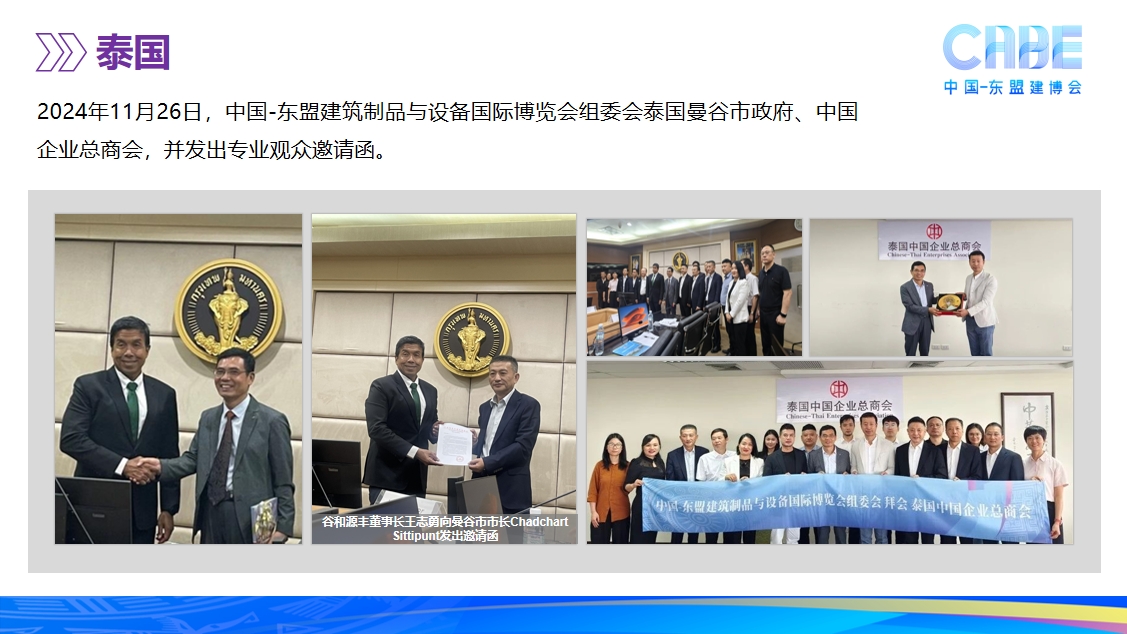
On the morning of November 29, the delegation visited the China Enterprises Chamber of Commerce in Malaysia (CECCM). The delegation was received by Li Anwei, President of CECCM Construction Branch and Managing Director of MCC Overseas (M) Sdn Bhd; Ding Qian, Vice President of CECCM and Managing Director of CEIG (M) Sdn Bhd; Huang Junqiang, a representative of CECCM President Unit and Business Manager of Malaysia Branch of CCCC Third Harbor Engineering Co., Ltd., and CECCM staff members.
Li Anwei introduced that CECCM was established in 2002 and has 357 Chinese-invested company members and 63 joint conference members, spanning industries such as construction, manufacturing, logistics, information technology, trade, and aviation. He detailed the services provided by CECCM to members and shared insights into local construction market demands. He emphasized that door and window products, particularly fire-rated doors, require local testing and certification to be used in engineering projects. An effective way for Chinese companies to explore the Malaysian market is to collaborate with local distributors and gain access to the supplier lists for projects or owners.
Pan Guanjun introduced the CCMSA and the delegation members, and explained the purpose of the visit. The representative companies then presented their signature products, shared their market experiences in Malaysia, and highlighted areas for potential collaboration.
On the afternoon of November 29, the delegation visited the headquarters of the Malaysian Chinese Association (MCA). The delegation was warmly received by Datuk Koh Chin Han, MCA Central Committee Member and Deputy Chairman and General Secretary of the MCA PRC Affairs & BRI Committee; MCA Central Committee Members Chen Zhangwang, Zhuang Zhixiang, and Lan Ziyuan; Huang Guoqiang, Chairman of MCA Selangor PRC Affairs and BRI Committee; Datuk Yu Fuhua and Wong Zhi Xuan, both Deputy Chairmen of MCA Selangor PRC Affairs and BRI Committee; Khoo Ai Theng, Deputy Secretary-General of MCA Youth; Teoh Tuck Wah, MCA Youth Central Committee Member; Xiong Guobao, Chief of MCA Bangi Youth Affairs Bureau; Qiu Dingxiong, Treasurer of MCA Selangor Youth Affairs Bureau; and Chen Jieyu, Deputy Director of MCA Selangor BRI Committee.
The exchange meeting was chaired by Wong Zhi Xuan. Koh Chin Han delivered a welcome speech on behalf of the MCA, and attendees watched a short video introducing the development history of the MCA and the Malaysia-China Belt and Road Economic and Trade Information Consultation Centre.
Pan Guanjun expressed gratitude to the MCA leaders for taking time to meet the delegation. He briefed on China’s economic development, the construction industry’s market trends, the CCMSA, the delegation members, and the purpose of the visit.
Both sides then discussed issues of mutual interest and agreed to enhance future exchanges. The MCA encouraged Chinese companies to explore opportunities or invest in Malaysia, pledging support within their means.
The Malaysian Chinese Association (Party MCA or MCA), established on February 27, 1949, is a legal political group composed of Malaysian Chinese and citizens of Chinese descent, representing the Chinese community.
Established in July 2014, the MCA PRC Affairs and BRI Committee serves as a crucial bridge for Malaysia-China relations. It is committed to strengthening economic, trade, and investment ties, offering support and facilitating business activities for Chinese companies in Malaysia, and fostering complementary and mutually beneficial commercial relations.
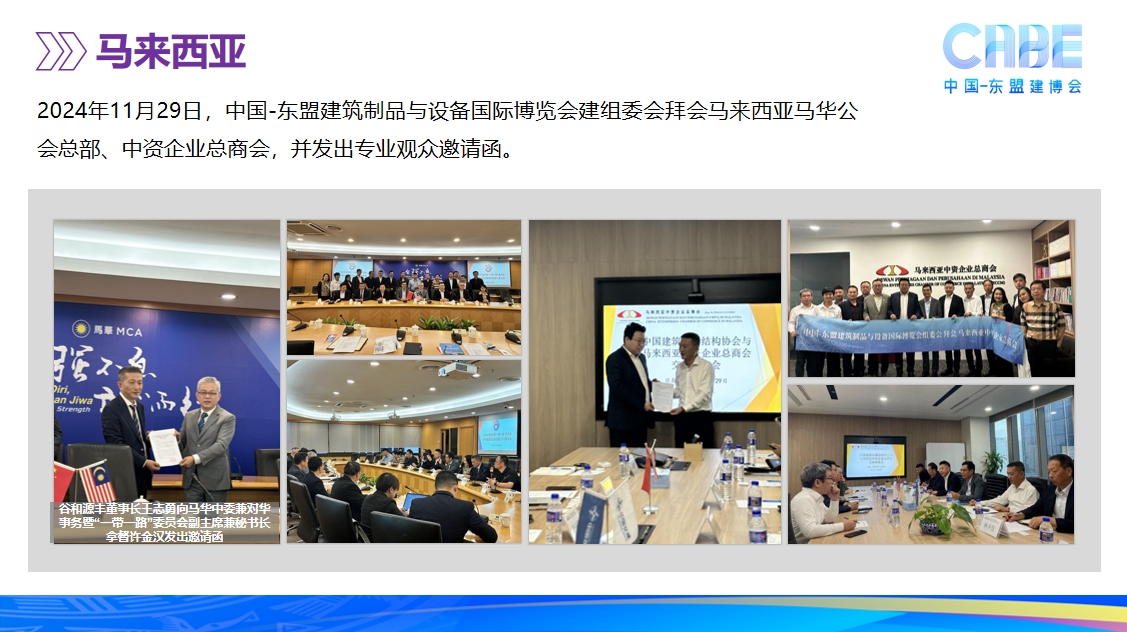
In Malaysia, commercial outlets predominantly utilize glass spring doors and roller shutter doors, with limited use of automatic sliding doors and almost no swing gates. Industrial doors are mostly standard roller shutter doors, supplemented by a few high-speed roller shutter doors. Residential buildings primarily use non-insulated single-glazed aluminum alloy casement windows, with some plastic windows and insulated single-glazed aluminum windows. Parking lots and courtyards primarily use card-operated barriers, along with a small number of retractable and sliding gates.
During the visit, Wang Zhiyong, Chairman of Guangxi Nanning Guheyuanfeng Convention and Exhibition Planning Co., Ltd., representing the organizer of the CABE 2025, invited relevant leaders to lead delegations to the CABE from November 14 to 16, 2025.
This visit provided insights into the construction industry policies, market demand trends, current standards, and market access regulations of the four countries, laying the groundwork for guiding China’s building doors and windows industry to expand globally in the future.
Annex: List of Delegation Members
Pan Guanjun, Deputy Secretary-General of CCMSA
Lin Xifan, Director of CCMSA Automatic Door and Electric Door Branch and Director of the Steel and Wood Doors and Windows Committee
Wang Ying, Deputy Director of the Steel and Wood Doors and Windows Committee
Ma Junqing, General Manager of Beijing Milan Window Energy-Saving Building Material Co., Ltd.
Li Xiaoyan, Secretary-General of Guangxi Construction Industry Federation
Wang Zhiyong, Chairman of Guangxi Nanning Guheyuanfeng Convention and Exhibition Planning Co., Ltd.
Wang Hui, General Manager of Zhejiang Xingyue Security Technology Co., Ltd.
Zhou Guoqing, General Manager of Shandong Ruizhe Automation Technology Co., Ltd.
Cui Yingjie, General Manager of Zhejiang Kingdom Doors Industrial Co., Ltd.
Yang Guoyuan, General Manager of HEINDA Door Control Co., Ltd.
Jia Chunlin, Chairman of Jiangsu Dantes Technology Co., Ltd.
Deng Lianghui, Chairman of Huixi International Co., Ltd. and Secretary-General of the Secretariat of the RCEP Business Association Liaison Mechanism in Nanning






